How to achieve business automation success in the post-COVID world: The definitive guide for SMBs and enterprises

With the COVID-19 pandemic not yet in the rearview mirror and the rise of the Delta variant, teams and businesses of all sizes are recalibrating their strategies to face the new challenges. In 2022, the priority will likely shift from sporadic adoption of business automation technologies to actually making their deployment a success. However, there’s still little clarity on the steps that need to be taken and the factors that influence the successful implementation of business automation.
In this blog, we’ll share how to develop a working business automation strategy that delivers results. Also, we’ll explore the present-day state of automation adoption and provide real-life examples of how businesses can maximize their revenue with business automation solutions. Let’s get started!
What is business automation?
The terms “digital transformation” and “business process automation” (BPA) are sometimes used interchangeably, which can cause confusion. In a very general sense, business process automation is a means, while digital transformation is the final goal. Business automation continues to be one of the dominating tech trends in 2022 that drive digital transformation across different industries.
Business automation leverages digital technology to make routine processes/repetitive tasks more efficient by eliminating human intervention. The use of automation also increases transparency and reporting capabilities, streamlines document workflows and accelerates signature cycles via eSignature solutions.
Business process automation vs business process management: what’s the difference?
It’s important to distinguish between business process automation (BPA) and business process management (BPM). While BPA focuses on digitizing and automating workflows, BPM is about managing those workflows from end to end. Business process automation relates to other forms of automation, such as Robotic Process Automation (RPA) and Digital Process Automation (DPA).
- Robotic Process Automation (RPA) uses bots that imitate human behavior to complete repetitive, rule-based tasks that have defined inputs and outputs. RPA is used for many labor-intensive knowledge tasks such as data entry, data processing and mapping, client onboarding, etc.
- Digital Process Automation (DPA) is a method of using digital technology to automate processes and optimize workflows. DPA focuses on automating tasks that involve human interaction in management, sales, and marketing. It extends the efficiency delivered by BPM solutions to customers, vendors, and other stakeholders, thus improving user experiences.
As we progress past COVID-19, experts are taking note of the 5 TOP business automation trends 2021 such as intelligent automation, hyper automation, no-code automation bots, cloud automation, and more.
How fast does business automation happen in 2021?
In the first few months of 2020, the COVID-19 crisis accelerated digital adoption at both the enterprise and industry levels by several years. According to McKinsey & Co., between December 2019 and July 2020, the digitization of customer interactions sped up by an average of three years, while the amount of digital product and service offerings skyrocketed by an average of seven years.
This tremendous leap would not be possible without the fast-paced digitization of businesses. Recent airSlate research suggests that early investment in the digitization of the most critical business processes facilitated faster recovery for 55% of business owners. On top of that, 54% of companies implemented eSignature during the pandemic, noting that its increased efficiency and productivity benefited their business.
In 2021, enterprises began adopting automation technology with more caution which, in turn, slowed down the deployment of emerging IT automation technologies. According to Gartner’s 2021-2023 Emerging Technology Roadmap for Large Enterprises, of all the IT automation technologies profiled in 2021, only 20% of them moved ahead in the adoption cycle, compared with 30% in 2020.
On top of that fact, as the response to the pandemic has matured, so too has it caused the demand for new digital workplace technologies to plateau. Only 12% of digital workplace technologies have moved ahead in the adoption cycle in 2021, compared with 41% in 2020.
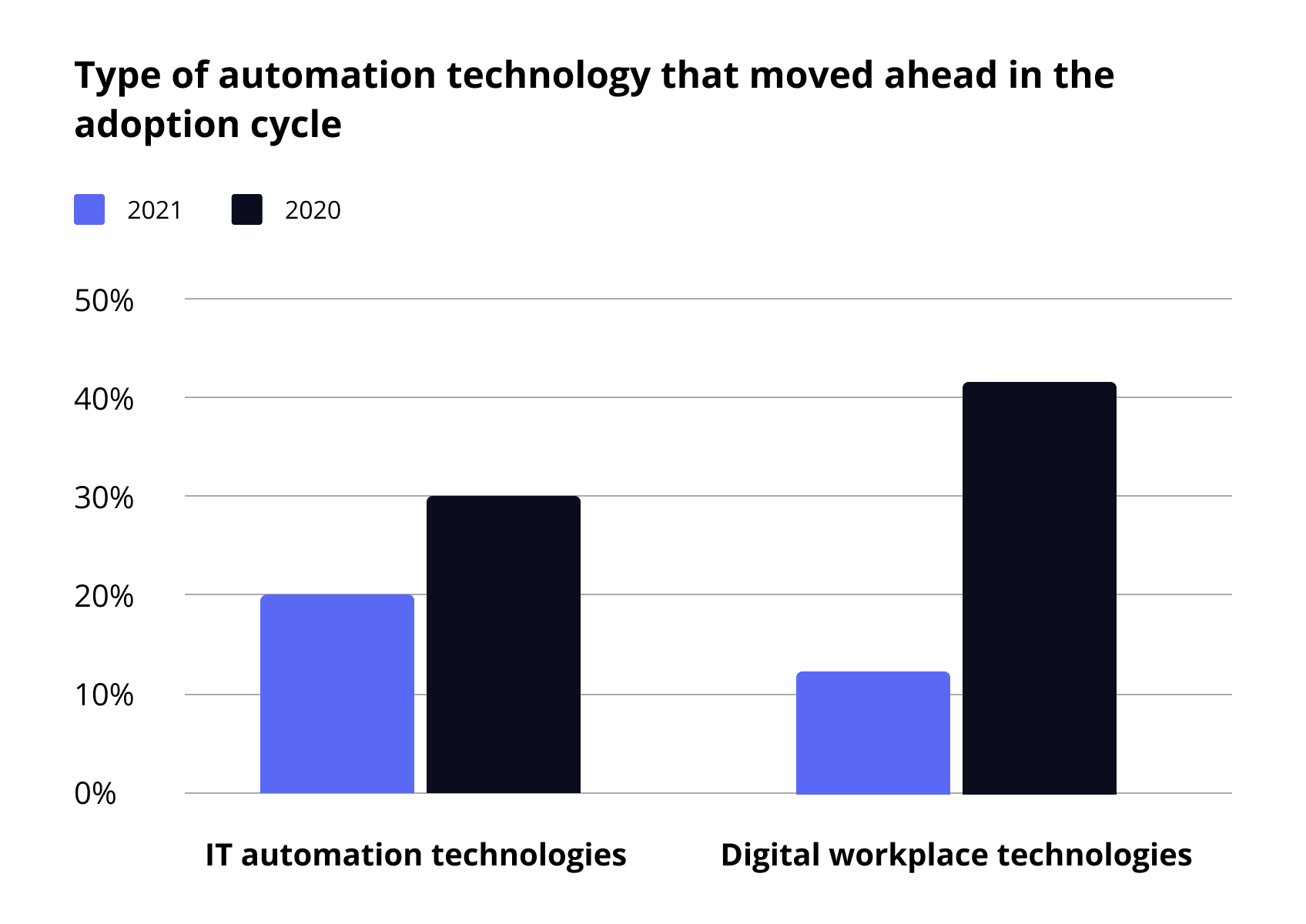
Source: Gartner, 2021-2023 Emerging Technology Roadmap for Large Enterprises
The lack of tech talent is cited as a serious impediment to leveraging automation across a number of domains such as computer infrastructure, platform services, network, security, digital workplace, IT automation and storage, etc.
This poses a number of challenges for business owners that go beyond achieving automation success. It also touches upon the need to recalibrate business strategies along with attracting, retraining, and/or upskilling existing talent with skills that make automation and continuous delivery possible.
8 key factors empowering successful business automation for SMBs and enterprises
Organizations that successfully leveraged automation during the pandemic point to three tactics for making it work:
- Designating automation as a strategic priority
According to a McKinsey survey, 38% of organizations that prioritized automation during their strategic planning process, reported automation success. Companies that pursued automation programs for the sake of long-term cost savings, to keep up with competitors, or to amplify the effectiveness of their business processes, haven’t succeeded with their automation efforts. On the other hand, organizations that scaled automation enterprise-wide were nearly five times more likely to report success.
- Pursuing people-focused initiatives
Massive digitization has encouraged organizations to foster people-focused initiatives such as attracting, retraining, and upskilling talent with digital and automation skills. Moreover, 65% of organizations reporting automation success are adopting “human-in-the-loop” solutions that combine machine and human intelligence to scale their automation efforts. Finally, successful organizations are seven times more likely to prioritize communication and gather employee feedback while leveraging automation.
- Developing an operating model that enables scaling
Organizations reporting automation success are facilitating better coordination across business units or functions to support their automation efforts. As operating models are becoming more complex, only 46% of leadership teams completely understand the cost of the automation efforts implemented within their organization.
As businesses are moving towards a post-COVID world in 2022, it’s crucial to reflect on the key factors that will impact business automation success for medium-sized businesses and enterprises in the months to come:
- Modularity and packaged business capabilities (PBCs).
Businesses that build solutions for a new modular economy use APIs and split components into microservices, also known as packaged business capabilities (PBCs).
- Automation guidelines
Developing consistent and coherent best practices to make business automation work for a given organization typically includes the following:
– choosing a process to automate and the solution and meet specific business needs
– defining the automation goals and the desired ROI
– establishing the roles and hierarchy of the stakeholders involved in the process to ensure accountability
– training the workforce and fostering upskilling/reskilling programs
– deploying and managing the automation solution
- Agile implementation
Avoiding technology and the occurrence of vendor lock-in when deploying an automation solution. A vendor lock-in prevents a customer using a specific product/service from easily transitioning to a competitor’s product/service. Using proprietary technologies incompatible with competitors’ APIs, configurations, and features, as well as contract constraints, are some of the reasons for a vendor lock-in.
- Democratization of app development
Using no-code tools for business automation opens new opportunities for citizen developers. By lowering the entry barrier for employees with no technical backgrounds and bringing the business side into app development, businesses can tackle the tech talent shortage and lessen the burden on strapped IT teams.
- CIO leadership
Chief Information Officers (CIOs) are strengthening their positions as enablers of business automation by helping to choose, deploy, manage, supervise, and govern automation solutions.
If still think of business automation as a sophisticated and frightening technology? Watch the video below to dispel the myth:
How composability enables automation. What is a composable enterprise?
The business automation success narrative wouldn’t be complete without mentioning a composable enterprise. Striving for resilience and agility in a time of uncertainty, organizations abandoned traditional, efficiency-oriented business models in favor of composability and modularity.
According to Gartner, a composable enterprise is based on the three building blocks:
- Composable Thinking, which ensures a better understanding of the business modules to compose, and the best time to do that.
- Composable Business Architecture, which ensures a better understanding of the structure, purpose, and mechanisms to use when making your business flexible and resilient.
- Composable Technologies, which ensures a clear view of product design goals driving the technology features that support the tenets of composability.
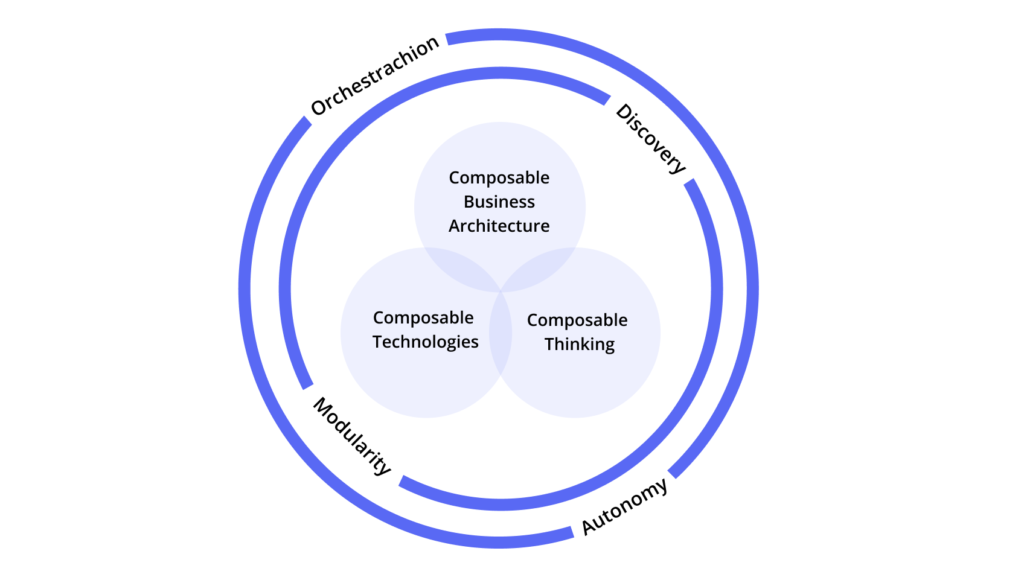
When it comes to leveraging automation in IT, organizations often teeter between the two extremes. On the one end of the spectrum, there’s an organization with great automation, but with added complexity because multiple vendors control different parts of the whole solution. It takes a lot of work to develop and maintain systems across that kind of environment.
On the other end of the spectrum, there’s an organization with an easy-to-manage automation environment, with very limited capabilities. Composability helps to get the best of both worlds by making it easy to automate a composable infrastructure and everything within it.
How composability enables automation
Organizations that were able to quickly recalibrate their strategic plans using the principles of composability were better prepared to survive the pandemic. Gartner indicates that by 2022, 70% of medium-sized and large organizations will prioritize composability in their approval criteria for new technology application plans.
By transforming the digital delivery process according to the principles of composability, businesses will be better positioned to benefit from digital economies. The composable enterprise is an adaptive, flexible, and long-lasting business model that can help businesses succeed in the post-COVID world.
In a composable enterprise, any kind of business automation — from robotic tasks to customer-facing apps — can be assembled using digital building blocks, known as packaged business capabilities (PBCs) comprising APIs, connectors, and other integration elements.
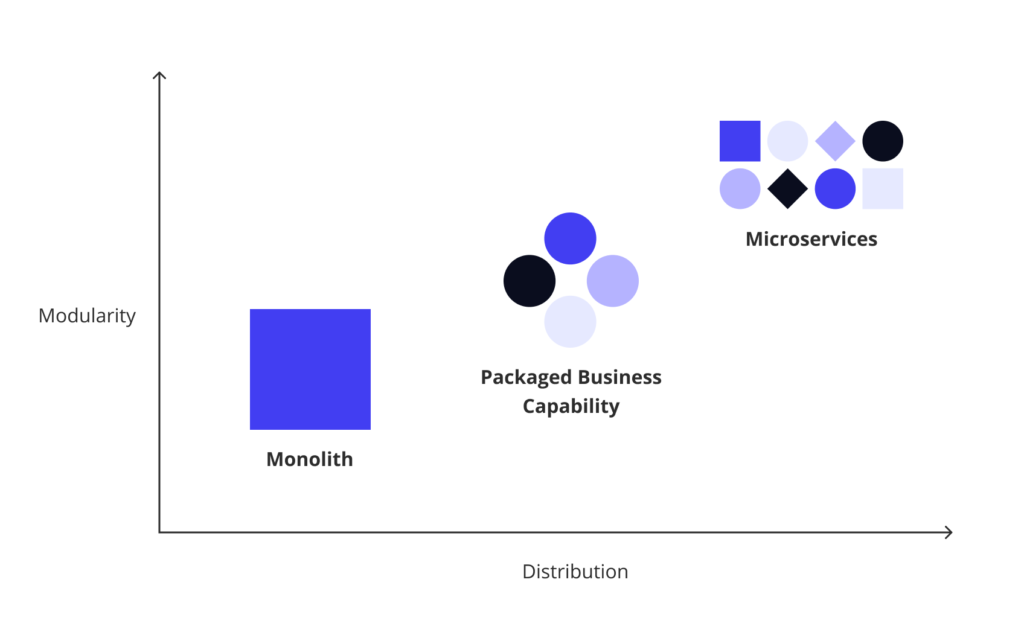
PBCs allow teams (both the in-house IT and citizen developers) to deploy existing digital capabilities along with discoverable and reusable modules, thus enabling a composable enterprise. Instead of relying on custom integrations and code, the composable enterprise model utilizes the API economy by extending its core capabilities through PBCs to partners, customers, and developers.
Key areas where business process automation delivers great results
Can all business processes be automated? When it comes to leveraging business process automation in a given organization, there’s often very little clarity as to the processes that must and must not be automated. There are 5 types of work that are typical for most organizations:
- Repetitive work is routine work that doesn’t require any special knowledge, skills, or human interaction, but at the same time, is highly prone to error. This is typically clerical work, manual data entry, copy-paste input, and so on. Implementing automation should increase the accuracy and speed of routine work by leveraging rule-based Automation and Integration Bots.
- Administrative work is important for supporting other types of work in core business operations. Despite being high-stakes work, it usually requires moderate skill to complete. Administrative work may be connected with compliance and documentation for various regulatory systems. Leveraging automation should relieve the burden of paperwork and regulatory compliance by digitizing and introducing proper management for various types of documentation.
- Departmental work, such as expense tracking and approval, ensures that a department is running, but it doesn’t influence the core business product. Implementing automation should help reduce departmental work with low-code and no-code apps that handle processes that would otherwise involve hard-to-manage documents and spreadsheets sent over email.
- Cross-enterprise work involves multiple departments working together on tasks such as processing insurance claims or loan approval. Leveraging automation should help deliver end-to-end customer experiences with straightforward processing, while also enabling the integration of individual business operations from across an enterprise into one process aligned with customers’ needs.
- Expert work, such as personalized consultation, cannot be totally automated, as it requires human interaction. Leveraging automation can eliminate routine work and increase the efficiency of an Expert’s work by keeping track of important details and providing them with deeper insights and recommendations for action.
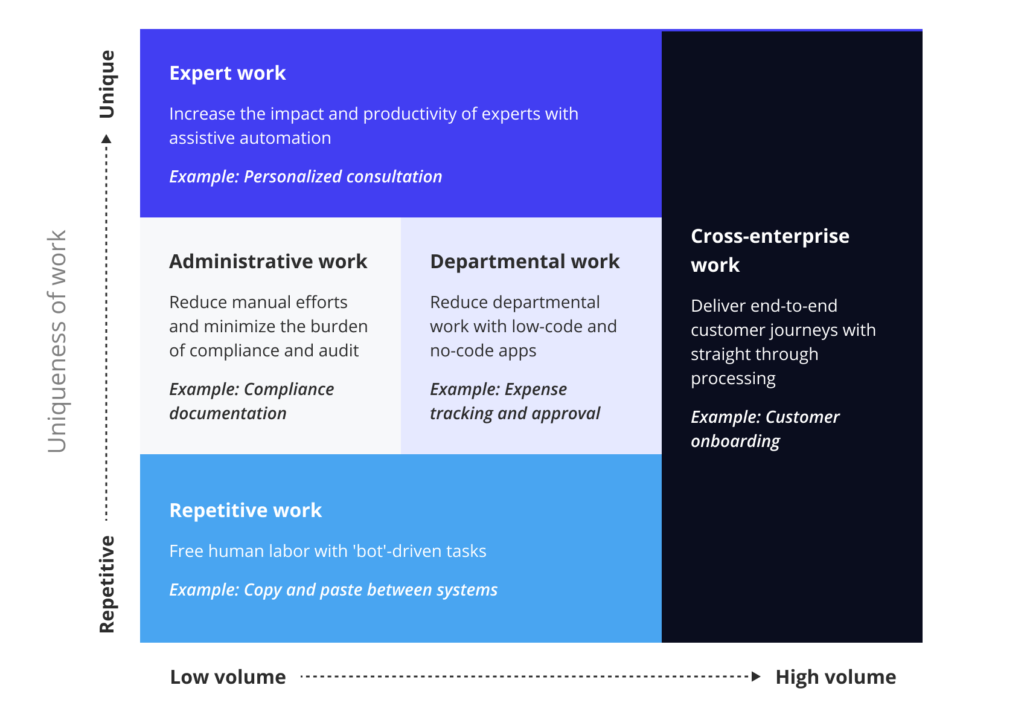
Business processes that cannot be automated
- Processes that require complex decision-making and critical thinking capabilities. Although it’s possible to automate some approvals and rejections with basic business rules and conditions, humans must be involved in making more complex decisions. In case there’s complex decision-making to be done, using automation can speed up the process by giving strategic oversight through detailed reporting.
- Processes that could potentially involve emotions shouldn’t be completely automated. These include some HR processes such as change management, giving feedback, the offboarding process, etc.
- Processes that don’t have a fixed structure or change frequently are often difficult to automate because it’s hard to identify specific rules or conditions that can be applied to such a process.
Business processes that can be automated
Here’s the list of the top 5 business processes that can be automated with a no-code workflow automation solution, such as airSlate:
- Contract management
According to the World Commerce and Contracting Association, the average cost of processing a single contract manually can reach a whopping $6.900. An automated contract management workflow can help businesses save up to 2% of their annual costs while also avoiding inaccuracies and non-compliance. airSlate’s automated workflows helped Claremont Graduate University speed up its adjunct contracting process and eliminate redundant physical paperwork and multiple digital backups. The deployment of a custom Request to Visit Campus Flow Template resulted in over 500 requests to visit the campus received and processed on a weekly basis from students, faculty, and staff members.
When I realized the power of the system, I sent 35 contracts for signature in one day. By next morning, we had half of them back signed. By the end of the week, we had 34 or 35 back signed.
- Student enrollment
The pandemic has revealed the drastic need for digital transformation and automation in education. According to Boston Consulting Group, 70% of higher education leaders are prioritizing digital technology for their institutions. Leveraging airSlate workflow automation helped Rock The Street, Wall Street finance school for girls to streamline its student enrollment process. airSlate’s no-code integration with Salesforce allowed forms to be sent in batches and be instantly archived the moment students submitted their completed forms for enrollment.
We probably have about 1,200 students or adult volunteers who’ve filled out our airSlate forms. Two of us at Rock The Street, Wall Street are currently using airSlate on a daily basis for our programs.
- Patient intake
Healthcare automation helps hospitals, clinics, and other medical institutions to make the process of managing healthcare information smooth, legally compliant, and error-free. Statista indicates that in 2020, 90% of large healthcare organizations developed an AI and/or automation strategy, while 34% of medical institutions already had healthcare automation solutions in place. airSlate helped T2 Biosystems streamline, accelerate, and secure their patient intake procedure. airSlate’s flexible no-code automation and integration with Salesforce enabled T2 Biosystems to easily share forms with end-users and secure partially completed information for future use.
The flexibility of airSlate allowed us to design a workflow that works for us. The automation built into airSlate helped us remove many manual steps in our old process.
- Employee onboarding
Over 50% of standard HR processes can be automated using RPA solutions, according to Deloitte. airSlate can be used to automate repetitive HR tasks, such as employee on/offboarding, attendance tracking, data management, HR analytics, and more. You can learn how to configure your onboarding workflow in airSlate, or use a pre-configured Employee Onboarding Process Flow Template to automatically collect new employee information for future use.
- Price quoting
About one-third of processes in the sales industry, including lead identification, sales strategy and planning, configuration, price and quotation (CPQ), can be automated. According to Aberdeen’s report, CPQ-enabled sales reps require 27% less time which equals about 3.6 hours to produce a typical quote or proposal than those not using CPQ. airSlate allows for automating the most common sales processes with its pre-configured Sales Invoice Process Flow Template and Sales Quotation Flow Template.
Business automation: where to start?
Before making serious investments in automation technology, a business should consider launching a pilot automation project that can deliver fast results with minimal deployment risks. Doing so can help any organization make a strong case for scaling up.
- Choose a process or project that is not mission-critical – something that will be worth the effort and will demonstrate value when completed. Refrain from choosing a project that can break everything.
- Keep the outcomes you wish to achieve with automation in mind. The first project should be a front-or back-office operation that is important to the business. Be sure that you’ve mapped out the desired state or experience.
- Look at the industry leaders, especially those who are growing fast, to get an idea of the possible outcomes. Look at the totality of their work, which may include dozens of individual automation projects. All in all, they will add up to a completely transformative approach.
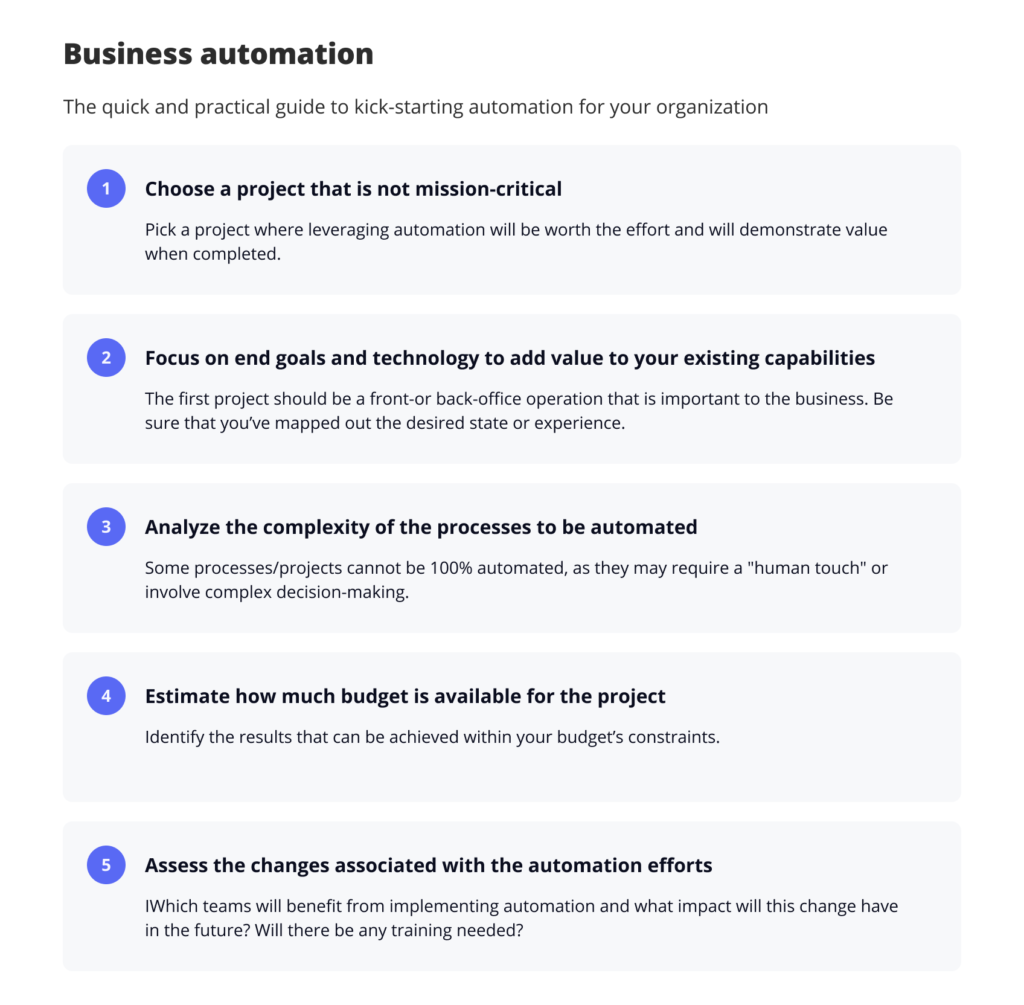
How to maximize revenue with business automation solutions
Assessing the ROI delivered by automation is crucial for operating in the post-pandemic world. When considering the implementation of automation, organizations typically focus on direct labor savings. In fact, automating complex human capabilities can significantly increase cost savings, while using AI to reinforce sales and marketing activities can boost revenue.
Deploying automation solutions in large enterprises can lead to staggering ROI (in the triple-digit percentages). In one example, a major service provider used automation to orchestrate their network services, which resulted in an overall productivity increase of 60 to 70%. Over five years, that translated to an ROI of 383% and savings of up to $16.7 million for Tier 3 to 5 providers. Meanwhile, Tier 1 and 2 operators reported savings that exceeded $70 million over the same period.
In a final example, by leveraging an automation solution and open-source operating system, a global manufacturer reported a net present value (NPV) of $231 million and an ROI of 42% over five years.
For SMBs, automation delivers a number of benefits such as streamlined workflows, better data management and processing, increased accuracy, and more. For instance, a workflow automation solution like airSlate can alleviate the pains associated with analog processes using automation or integration Bots. If properly configured, Bots will complete any task by performing a sequence of operations based on pre-set triggers and conditions, no human intervention is required.
Is hyper automation the future of business automation?
Gartner forecasts that the global market for hyper automation-enabling solutions is projected to reach $596.616 billion by 2022. More and more organizations will be looking to digitally empower their essential business processes while also reconfiguring human labor and manual routines. To prepare for future disruptions, companies continue to reduce their reliance on a human workforce for completing routine digital tasks. Hyper automation is becoming commonplace as it is viewed as the next stage of business process evolution.
Hyper automation refers to the deployment of advanced technologies, such as robotic process automation (RPA) and artificial intelligence (AI) to automate recurring and tedious tasks that were typically handled by the human workforce.
Unlike robotic process automation that utilizes rule-based bots to imitate human behavior to complete repetitive tasks, hyper automation leverages the new “blended workforce” where bots operate alongside humans. This way, hyper automation allows organizations to improve their customer experience while reducing operational expenses and increasing profitability.
A recent Deloitte report indicates that leveraging hyper automation has a number of potential benefits, including:
- Workforce enablement
Employees can increase their productivity by automating business processes within their roles with digital tools and resources at hand. Eliminating menial tasks allows them to focus more on planning and strategy.
- Employee upskilling
Fostering people-focused initiatives and citizen-led innovation within an enterprise will allow for any business user to become an automation leader. Moreover, bringing the business side into the development process will translate into improved internal collaboration.
- Systems integration
Hyperautomation utilizes a combination of automation tools with machine learning apps and packaged software used to deliver working results. Creating a hyper automation ecosystem within an organization will allow for the seamless integration of on-premise technology and disparate data systems.
- Improved ROI
With advanced analytics, organizations can assess the efficiency of hyper automation based on the number of business-optimized processes and costs saved. According to Gartner, by 2024, organizations will cut operational expenses by 30% using hyper automation technologies and redesigning their operational processes.
Are CIOs the only enablers of business automation?
One of the biggest changes wrought by the pandemic is the increasing importance of CIOs (Chief Information Officers). The role of the CIO emerged as a job title in the 1980s — highly technical professionals who would manage an IT department’s resources and staff. As businesses become more and more digitized, CIOs would become true strategic business partners that drive innovation and digital transformation, introducing revenue-generating objectives throughout a business’s digital expansion.
Today, CIOs are positioned to be the enablers of business automation by helping to select, manage, monitor, and properly govern the new wave of automation solutions. However, in many organizations, the responsibility for selecting and implementing new automation technology and SaaS solutions doesn’t lie solely in the hands of the CIOs.
With sales cycles becoming shorter, teams and individuals are now entrusted with the deployment of specific technologies and also with introducing them to others to try. The pandemic has pressured organizations to democratize their software development practices. Technologically cumbersome solutions requiring the constant supervision of IT have proven to impede workplace productivity and efficiency. They are being replaced with low-code or no-code tools to empower employees without technical backgrounds, known as citizen developers.
In a post-Covid economy, using PBCs and taking an API-led approach can help CIOs enable their organizations to leverage automation across multiple business units. CIOs should ensure that the automation strategies they deploy include the following key characteristics:
- Composability. Automations and insights composed from reusable PBCs are easier to access and repurpose.
- Central governance. Irrespective of the architectural patterns, it’s crucial for an enterprise to offer, manage, promote, and secure PBCs through a centrally-governed platform to ensure consistent app connectivity and automation.
- Standardized automation. Whether it’s simple automation of robotic tasks or a highly orchestrated automation with branchable business logic, whatever the type of automation is it should inherit the best practices and standards applied by centrally governed PBCs.
- Fostering citizen-led innovation. Business users must have the tools and knowledge to execute on automation opportunities irrespective of an IT backlog.
- Avoiding lock-ins. CIOs working under the composable enterprise paradigm must ensure that PBCs are open to consumption by a variety of tools and avoid any possible lock-ins.
How to assess business automation success?
Organizations that have achieved automation success typically share the following qualities:
- Customer-centric approach prioritizing the needs of customers.
- The ability to deliver a personalized customer experience while keeping scalability within sight.
- The ability to keep an automation system as flexible as possible by building on an extensive platform and keeping proper alignment between the business side and the IT.
- The ability to identify and eliminate inefficient and redundant processes.
A successfully automated organization will most likely need some of the following capabilities, depending on the processes that require automation to drive growth:
- Robotic process automation (RPA) and no-code Bots to automate manual processes
- Improved content sharing, management, and collaboration
- Tools to design and manage end-to-end workflows
- Basic decision-making automation with business rules
- Capturing and extracting data from documents
So, what do we mean by saying that an organization has achieved automation success? How do we correlate the time invested with the results? Automation success is a process rather than a final destination. This is because it doesn’t come from implementing a particular solution or finishing a specific project. It’s an ongoing process that adapts accordingly to an organization’s ever-changing business needs.
Contact us to explore the possibilities of business automation with airSlate.
Fill out the form below to request a free demo!
- What is business automation?
- Business process automation vs business process management: what’s the difference?
- How fast does business automation happen in 2021?
- 8 key factors empowering successful business automation for SMBs and enterprises
- How composability enables automation. What is a composable enterprise?
- How composability enables automation
- Key areas where business process automation delivers great results
- Business processes that cannot be automated
- Business processes that can be automated
- Business automation: where to start?
- How to maximize revenue with business automation solutions
- Is hyper automation the future of business automation?
- Are CIOs the only enablers of business automation?
- How to assess business automation success?

